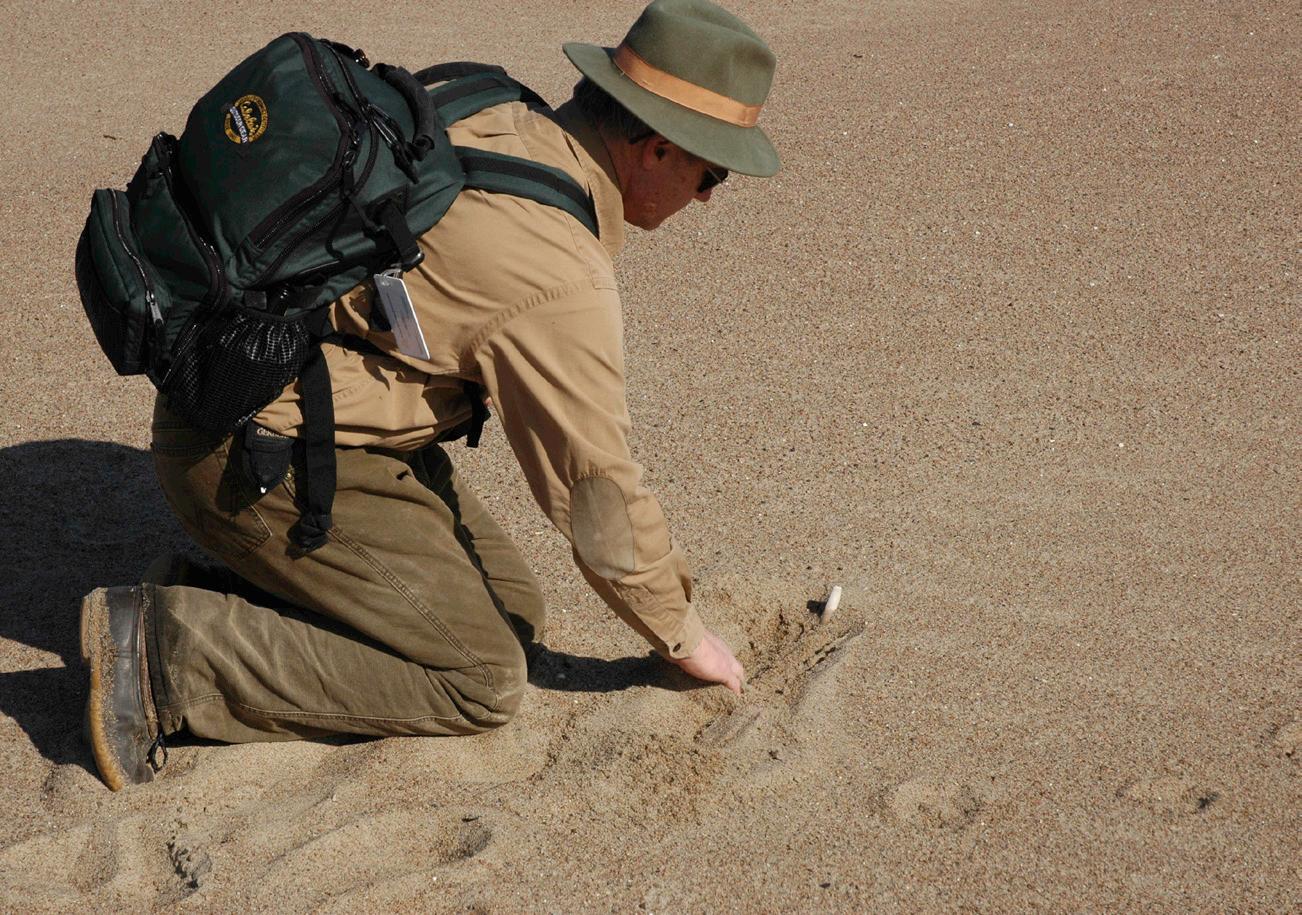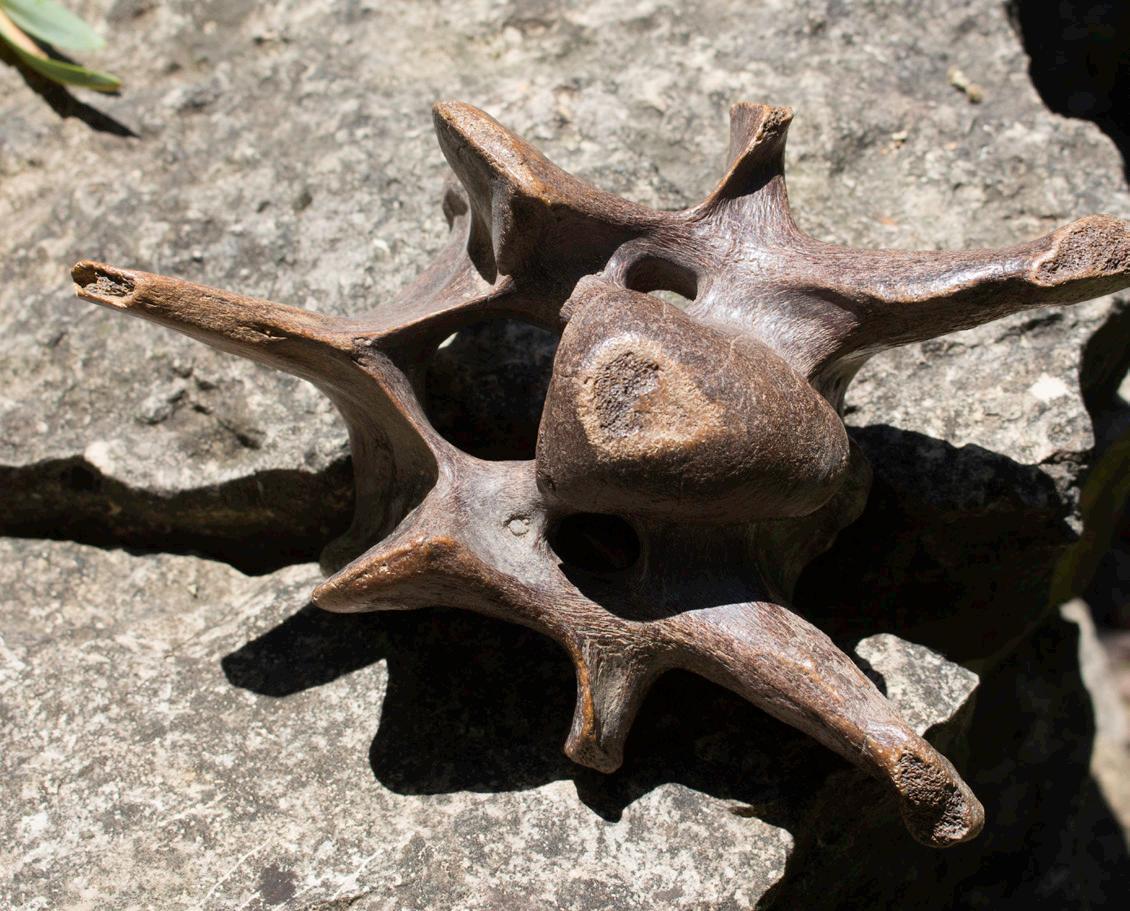
9 minute read
What is CFM?










Missouri’s Ground Squirrels

Most people have an opinion on squirrels. From setting out corn to attract them or actively discouraging their presence, it doesn’t seem squirrels enjoy much middle ground. Luckily for Missouri’s ground squirrels, they spend most of the year under the ground rather than above it.
Two species of ground squirrels are found in the state—the thirteen-lined ground squirrel and Franklin’s ground squirrel. Both hibernate from late summer or very early fall until March. Ground squirrels will give a clear, sharp whistle when alarmed. The thirteen-lined ground squirrel is named for seven light and six dark stripes on its back, although in reality, the number of stripes can vary with individual squirrels. Adding to its distinctive look, it sports diminutive ears and large claws for digging. These are small squirrels, about chipmunk-sized, maxing out at a little over 6 inches in body length with a tail that can reach the same length.
Habitat for thirteen-lined ground squirrels is open areas with short grass or vegetation that allows them to see over the top when they stand on their hind legs. Historically present in prairies with short vegetation, they are now also attracted to yards and golf courses, indicating their adaptability to land changes that humans have caused.
Thirteen-lined ground squirrels build underground tunnels up to 20 ft in depth. They move around the mounded, dug up soil at the entrance and pat it down with their feet. During the day the main entrance to the burrow will stay open, but at night the squirrels plug it with soil and vegetation. While they may live in loose, small colonies, they are solitary beings.
The diet of these easily identifiable rodents is seeds, plant vegetation, and insects such as grasshoppers and cicadas. Food with stability will be carried back to the nesting cavity underground and stored for later use. If food becomes scarce in summer, the squirrels are known to return to their nests and become inactive for a week or more. In late summer, they will gorge, adding significant body weight to prepare for hibernation.
Hibernation begins at the end of summer, thus ending these rodents’ short three to four months above ground. The entrance to the burrow is plugged, and they return to their den below the frost line where they remain until spring. Body temperature will drop close to that of the cavity and their heartbeat slows from 200 to 300 beats per minute to as slow as 15 beats per minute. Respiration will drop from 150 breaths per minute to just three to four per minute. They will wake for a very short time every two to three weeks to urinate. The fat they have gained by gorging is needed as they will lose one-third to a half of their body weight.
The Franklin’s ground squirrel is a bit larger than the thirteen-lined ground squirrel and even more secretive. Spending only about 10% of its life aboveground, the Franklin’s is very difficult to spot and highly secretive. The site of the burrow is near thicker vegetation, and the most frequent sightings are out along roadsides or railroad tracks. You will find a mound of dirt at the Franklin’s ground squirrel entrance to its burrow. Also nesting in small colonies—with little social interaction—these squirrels excavate an extensive underground series of tunnels.
They may also spend the hot part of the summer in dormancy in their burrow and tunnels. They are known to sometimes move locations of their colonies, but due to their secretive nature, much is not known about this behavior. The diet of the Franklin’s ground squirrel is largely much same as the thirteen-lined ground squirrel, including vegetation, seeds, insects, and small vertebrates. Amphibians, young rabbits, mice and other ground squirrels make up 25% of their diet.
Northern Missouri is the southern boundary of the range of this elusive ground squirrel. In 2003 the Missouri Department of Conservation requested that any Franklin’s ground squirrel sightings be reported to the department. A study from the preceding two years resulted in 44 sightings in 11 counties. While often favoring roadsides for their burrows, only six road-kills were collected in during the two-year study.
Both ground squirrel species were captured in splendid fashion by the artist John James Audubon in his book The Viviparous Quadrupeds of North America. Of special interest is the plate of the Franklin’s ground squirrel with a background depicting a Native American village and a war party. The thirteen-lined ground squirrel plate has the charming rodent set on the once vast prairies of the Midwest that had been their home for thousands of years.
As previously discussed, the status of the Franklin’s ground squirrel in Missouri is unknown. The thirteenlined ground squirrel is a species of conservation concern in Missouri. Grow Native! is a native plant education and marketing program of the Missouri Prairie Foundation, an affiliate member of CFM. Plant species that make up the prairies where Missouri ground squirrels historically made their homes are great additions to the home landscape. For more information on the native prairie plants of Missouri visit www. grownative.org.
Mary Nemececk
President of Burroughs Audubon
The thirteen-lined ground squirrel is a species of conservation concern in Missouri. (Photo: Courtesy of MDC)
Sandbar Archaeology

Awetter-than-average spring has the Missouri River bank-full today, but it’s only a matter of time until it falls to summer levels, exposing hundreds of sandbars or, as I like to think of them, time machines.
During spring floods, the Missouri and its thousands of tributaries carve away at geological deposits between the Rocky Mountains and St. Louis. It digs out bones of long-extinct animals, collects artifacts from Indian camps and unearths shark teeth that fell to the bottom of the inland sea that once divided our continent in two. Along the way, it also plucks trade goods from the rotting hulls of wrecked steam ships and objects whose origins and functions are mysteries.

Discovering an arrowhead or a huge leg bone triggers a welter of questions and speculation. Was the animal killed by a hunter or a saber-toothed tiger Who made the arrowhead? How did he or she lose it? Was it carried to this spot in the vitals of a deer… or perhaps a mastodon?? The result is a pleasant sort of temporal vertigo. One moment you have both feet planted firmly in the present. Then, in an instant, the currents of time are tugging you back to the Pleistocene period and beyond.
This year’s natural exhibit of historical artifacts is being arranged right now beneath the mochacolored waters of the Big Muddy. When it opens, admission will be free to anyone with a kayak, canoe or motorboat.
The Missouri Department of Conservation maintains dozens of river accesses at convenient intervals, making it easy to plan an expedition. The exhibit changes every time the river overtops sandbars and islands, and the first explorers get their pick of newly deposited prizes.
Sandbar archaeology has a small but dedicated following in Missouri. The holy grail of this group is a skull of a Bison antiquus. These huge grazers were 25 percent larger than modern bison and had horns a yard across. Every few years, a photo of a proud beachcomber displaying such a treasure appears in a river town’s newspaper.
My own personal best find was the topmost 1/3 of an elk antler. I nearly walked past it, because only one eroded tine poked a few inches above the level surface of the sandbar. At first, I thought it was a stick of wood. Then I noticed that it had a hollow core and looked as if it had been gnawed by a rodent, which made me think of antlers. Imagine my awe when I pulled on it and a massive, 2-foot end portion of an enormous antler emerged from the sand. The whole antler likely would have had 7 points.
Lee Lyman, then a professor of archaeology at the University of Missouri, identified my antler fragment as coming from an elk. North American elk are descended from Eurasian red deer that crossed the Bering Land Bridge into North America during the last ice age. The pattern of forking and slightly webbed junctions are intermediate between the typical antler shape of ancient red deer and modernday elk. Based on the degree of divergence from red deer, he estimated that my specimen was 7,000 to 8,000 years old.
Aside from Bison antiquus skulls – which are, let’s face it, unbeatable – the coolest thing I ever saw rescued from a sandbar was an intricately carved piece of personal ornamentation. Lyman identified it as a robe fastener. It was made from half of a turkey wing bone split lengthwise. It was jet black with age. The carving was exquisite in its detail and symmetry. What I wouldn’t give to know the story of this piece of art!

Pillaging artifacts and fossils from archaeological sites would be both unethical and illegal. However, once the river washes objects away from their original locations, they lose their geologic and geographic contexts, greatly reducing their usefulness in unraveling the history they represent. For this reason, items found on sandbars are fair game for collectors. If no one picks them up, they will only be washed downstream – and probably reburied forever – by the next flood. The exception is human remains, which must be reported to law-enforcement officials, even if they appear to be very old.
Artifacts found on the river are not entirely without scientific value, and professional archaeologists take a lively interest in amateur finds. If you make an interesting discovery, contact the archaeology faculty at the nearest university or the Missouri Department of Natural Resources’ State Historic Preservation Office. They can provide fascinating insights about their identity and origins. Then you can legitimately say you have added to the body of archaeological knowledge.
Jim Low
(Left) Sometimes the biggest finds barely show above the surface. (Photo: Jim Low)
(Right) This vertebra from a 10,000-year-old Bison antiquus turned up on a sandbar across from Jefferson City. (Photo: Jim Low)
(Top) Take your sandbar finds to a museum or university archaeology department to learn more about them. (Photo: Jim Low)










